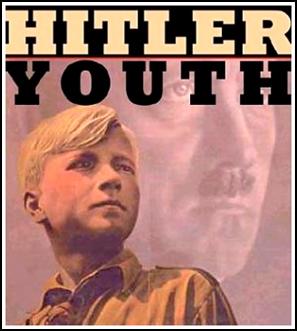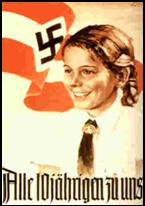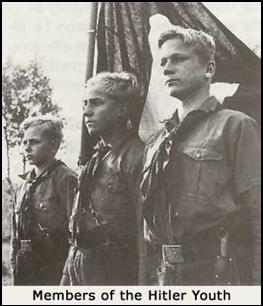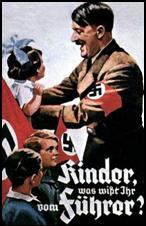




|
We are the joyous Hitler youth, - Song sung by Hitler youth |


|
Hitler Youth from Europe, history of Ever closer union?Discussed by philosophers for centuries, actively promoted from the 1920s onward by Count Richard Coudenhove-Kalergi's Pan-European Movement, and officially proposed in 1929 by Aristide Briand on behalf of France, the idea of uniting Europe was revived again as World War II approached. In Britain a small private group that called itself Federal Union--in close touch with others at the Royal Institute of International Affairs (Chatham House)--began to campaign for unity in Europe as a last frail hope of preventing war. Some of the papers produced by its distinguished supporters, including work by Lord Lothian and Lionel Robbins, found their way to another group of activists in the Italian Resistance, led by, among others, Altiero Spinelli. One of the most stubborn of Mussolini's political prisoners, he was freed in 1943 from confinement on an island off the coast between Rome and Naples. Admiring what he called "the clean, precise thinking of the English federalists," he echoed it in the declaration he drafted for a secret grouping of Resistance leaders from eight other countries, including Germany. Britain thus contributed to Continental developments that British governments shunned for many years.Support for European unity came from the right as well as the left, from liberals as well as dirigistes, from clerics as well as anticlericals, from "Atlanticists" as well as those who saw Europe as a "Third Force" between East and West. It even received official support, overt as well as implicit.In 1939 the British Labour Party leader Clement Attlee declared: "Europe must federate or perish." In 1940, prompted by Jean Monnet, Churchill's government, in agreement with General de Gaulle, proposed a political union between Britain and France. In 1943 Churchill called for a Council of Europe after the war, and de Gaulle's colleague René Mayer suggested an economic federation. In 1944 the exiled governments of Belgium, The Netherlands, and Luxembourg signed the Benelux Convention for a future customs union. Pope Pius XII, meanwhile, had envisaged a close union of European states.Individual supporters of European unity included not only statesmen such as Paul-Henri Spaak from Belgium, Alcide De Gasperi from Italy, Robert Schuman from France, Johan Willem Beyen from The Netherlands, Konrad Adenauer from Germany, and Joseph Bech from Luxembourg but also such well-known writers as Albert Camus, Raymond Aron, George Orwell, Denis de Rougemont, and Ignazio Silone. All urged, and many helped to organize, what Winston Churchill called in 1946 "a kind of United States of Europe."In 1948 a number of activist organizations, coordinated by Joseph Retinger, former assistant to the late General Wladyslaw Sikorski, head of the wartime Polish government-in-exile in London, staged a full-scale Congress of Europe in The Hague, Neth. Attended by 750 statesmen from throughout western Europe, including Spaak, De Gasperi, Churchill, Schuman, Adenauer, and a young French Resistance worker named François Mitterrand, it called for political and economic union, a European Assembly, and a European Court of Human Rights.Some governments responded sympathetically. The postwar constitutions of France, West Germany, and Italy all envisaged limiting national sovereignty: the German text specifically looked forward to a united Europe. The British, however, were skeptical; and when in response to proposals by the French foreign minister Georges Bidault (who had attended The Hague Congress) the governments took action, it was of limited scope. In May 1949 they set up the Council of Europe, consisting of a Committee of Ministers and a Consultative Assembly.To the activists, it was something; but it was not enough. The Council of Europe's main achievement, apart from useful studies and discussions, was to produce the European Convention for the Protection of Human Rights (1950), effectively backed by a court and a commission. But the Consultative Assembly was just that: it had no power, and the Committee of Ministers had a veto.The initiative to go further came from Monnet. His opportunity came when France was at loggerheads with Britain and the United States, both of which sought to remove the postwar restraints preventing German heavy industry from making its full contribution to the prosperity of the West. Monnet proposed to sidestep the dilemma by pooling coal and steel production in western Europe, including West Germany's, under common institutions to replace with a light and shared rein the heavy control that the International Ruhr Authority had imposed on West Germany alone.This was the essence of what became the Schuman Plan in 1950 when Robert Schuman, by then the French foreign minister, accepted it after Georges Bidault, the prime minister, had neglected to take it up. Its end product, initially embracing only six nations, was the formation of the European Coal and Steel Community, which began work in 1952.Monnet and Schuman saw this as only a first step on the way to a European federation. Monnet followed it by proposing to René Pleven a similar solution to the problem of German rearmament: a European Defense Community. When that eventually failed, he proposed to Spaak and Beyen what became in 1958 the European Economic Community (EEC) and the European Atomic Energy Community (Euratom), a similar organization for the peaceful use of nuclear energy. The three institutions were ultimately merged to become the European Communities (EC) in 1967. With a Council of Ministers to make essential decisions (if need be by majority vote), a Commission to propose policy, and a European Parliament and Court of Justice to exert, respectively, legislative and judicial control, the EC had the embryo of a federal constitution, limited to economic and social affairs.It also had the potential for crises, growth, and enlargement. Its first major crisis, indeed, concerned enlargement, when President de Gaulle vetoed the first British application to join, in 1963. The second crisis, two years later, was also provoked by de Gaulle, who objected to the extension of majority voting.The EC weathered both crises and proceeded to recruit new members alongside the original six of France, West Germany, Italy, and the three Benelux countries. First came Britain, Ireland, and Denmark, followed by Greece, Spain, and Portugal--with further candidates in the offing, notably Austria, Turkey, and Sweden. The possibility of further extension in eastern Europe was also mooted, despite doubts whether eastern European countries could yet face full EC competition and whether the EC might not be slowed down by too many new recruits.The EC has developed. Its basic customs union was to be completed by the removal of all nontariff barriers in a "single market" by the end of 1992. It has formed association agreements with the members of the European Free Trade Association (Austria, Norway, Sweden, Switzerland, Liechtenstein, Finland, and Iceland), set up alongside the EC by those European countries that failed to join. It has contracted aid and trade arrangements throughout the world, notably with African, Caribbean, and Pacific countries, many of them former colonies of its member states. In trade negotiations, it is big enough to act as an equal partner to the United States. It seeks economic and monetary union, with the possibility of ultimately adopting a single currency. It has set in place machinery for foreign policy coordination called "European Political Co-operation." It is pledged by treaty to "ever closer union." Only future generations can decide how close that may become.The EC was founded in response to a checkered half-century of European history. In 50 years some of the world's most civilized nations had plumbed depths of savagery, folly, tyranny, and genocide that in a work of science fiction would be hard to believe. The time had surely come to learn lessons from the past.The EC's first and most obvious purpose was to reconcile former enemies and prevent war. This meant not only forging indissoluble bonds between France and Germany but bringing Germany into the Western fold as an equal and not as an inferior, the victim of Versailles-style reprisals. By cementing Western unity, moreover, unilateral national action could be made impossible, eliminating the fear of revanche toward the East. The EC could thus be seen as an element in "confidence building" between East and West.Its second aim was to avoid the economic errors that Europeans had made in the 1930s, when instead of a global recovery policy they had worsened the crisis by the beggar-my-neighbour tactic of every man for himself. Economic nationalism of that sort had been the breeding ground for dictatorship. After World War II the foundations of a better approach had been laid by the OEEC. The EC went further, by pooling economic resources in a "common market," making national protectionist measures ever more difficult, and appointing an independent commission responsible for seeing the EC's problems not from separate national viewpoints but collectively, as a whole.Meanwhile, Europe's world status had drastically changed. Its individual nations, once great powers, were dwarfed--politically and militarily by the United States and the Soviet Union (until its dissolution in 1991-92), numerically by them and by India and China, economically by the United States, Japan, and any new economic powers that might emerge. Europe's empires had been dismantled; and yet, like the rest of the world's rich Northern Hemisphere, it could not shrug off the poor and hungry millions in the South. All the more reason, therefore, for European countries to come together--not merely to hold their own vis-à-vis political and economic superpowers but also to maximize their power to meet their wider responsibilities in the world.Finally, 20th-century Europe had witnessed and shared in extraordinarily rapid technological change. Computers, industrial robots, and genetic engineering are only its most obvious recent examples. The splitting of the atom had vastly multiplied humanity's power to destroy itself. Jet aircraft, space travel, and electronic telecommunications had revolutionized the sense of distance and scale. Radio and television, still more than the cinema, had become truly "mass media," with satellites giving all broadcasts global range.But economic progress had not kept pace with technology; in a world of potential plenty and well-being, there were still both penury and pollution. Political progress had been slower still. International cooperation was increasing, but the basic political unit remained the nation-state. That dated from an age when the fastest means of travel had been a galloping horse. This was why the founders of the EC, as Monnet said, were not concerned to make coalitions of states but to unite people. A united Europe along these lines, with common rules and democratic institutions, was in his eyes a pilot plant for a united world.(R.J.Ma.) |